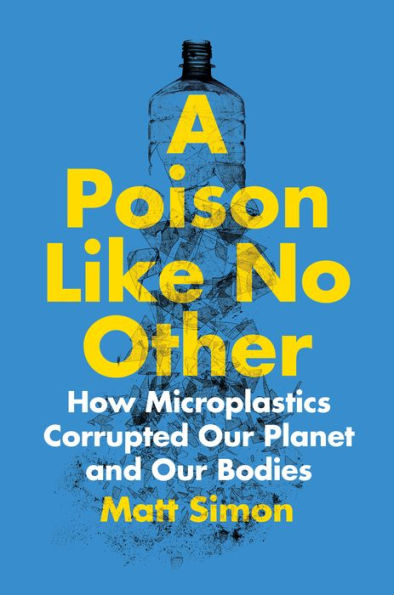A Poison Like No Other: How Microplastics Corrupted Our Planet and Our Bodies
- By Matt Simon
- Island Press
- 252 pp.
- Reviewed by Randy Cepuch
- December 13, 2022
Can’t live with ‘em, can’t live without ‘em.

“Plastics.” Fifty-five years ago, in the movie “The Graduate,” a well-meaning adult whispered this road-to-riches tip to a young college grad played by Dustin Hoffman. It wasn’t bad advice back then. Plastics were seen as miracles with unbeatable growth opportunities.
Now we’re beginning to deal with the costs. These days, plastics are literally everywhere — including in everything we eat, drink, and breathe. Over time, they decay into smaller and smaller particles, exposing more surface area and becoming a bigger and bigger problem. A Poison Like No Other by Matt Simon (a science writer for WIRED) looks at how it all went wrong. The book’s dedication makes his position clear: “To Planet Earth: Sorry about the mess.”
It’s an important book but a hard one to read. That’s partly because the problem is depressing and already seems so hopeless: We can’t put the genie back in the bottle (which is probably made of plastic). Unfortunately, it’s also because the book offers a plethora of statistics, but none converted to graphics, which would’ve made the information easier to digest. Of course, a lot of the information comes from educated guesses based on current knowledge, which underscores how much the experts just don’t know yet.
What we mere mortals do know for sure about plastics is even less. We think we’re being dutiful when we re-use plastic bags or put plastic bottles in the recycling bin — and we are, but nearly all of what we attempt to recycle ends up in landfills anyway because it’s so much cheaper just to make new plastic. (This makes oil companies very happy; petroleum products are the main ingredients in plastic.)
We tend to overlook less obvious uses of plastic, though: in clothing, for instance. “We are all like Pig-Pen from the Peanuts comics,” writes Simon, “who swirls with a perpetual aura of dust, only we’re depositing our microfibers wherever we go.”
Every time we do a load of laundry, tens of thousands of plastic microfibers break free and make their way to water-treatment facilities that simply can’t snare them all. The abrasive qualities of detergents multiply the effect, which could be greatly reduced if washing machines included filters (as dryers do).
Cosmetics such as lipsticks and eyeliners often include microplastics that end up going down the drain. Until recently, so did many toothpastes. Carpets and tires are constantly shedding plastic bits. And particles of plastic-based paints — typically used on shiny surfaces like the sides of ships — are shed “like dandruff,” Simon notes.
Transported by wind or water (and assisted by humans or animals), plastic debris has found its way to the top of Mount Everest and the bottom of the Mariana Trench. It has also ended up inside all of us and is linked to more than a few health issues, including our obesity epidemic.
Early in the book, Simon breaks stride to admit that “this stuff is heavy, I know it, and I’m feeling your unease. But I promise we’ll be talking about solutions, ranging from individual actions to ways to break plastic’s grip on our civilization. Microplastics are a serious problem, but not an impossible problem to mitigate.”
Some measures of seriousness don’t really convey, however, at least not via text. California, we’re told, estimates that it pumps the equivalent of 80 million rubber duckies into the environment each year. And one estimate of plastic shed annually from tires around the world is that it would fill 31 container ships, each a quarter-mile long. Part of the challenge of getting our heads around the scope of the problem is that the amounts themselves are unfathomable.
By the way, in case you’d been wondering how much plastic has been produced since the stuff was invented in 1863 as a substitute for turning elephant tusks into billiard balls, Simon says a rough guess is “more than 18 trillion pounds, twice the weight of all the animals living on Earth.” (He adds that that’s more than enough to wrap our planet in cling wrap.)
Simon’s most important recommendation is the obvious one: Humans need to “majorly [curtail] the production of plastics.” Yet he doesn’t suggest plastics can or even should go away completely. As those who profit from the industry like to remind us, plastics are essential to modern medicine, the safe distribution of electricity, and lightweight, inexpensive shipping. So far, plant-based substitutes have enjoyed limited success for a variety of reasons, most notably that “biodegradability” is far from guaranteed.
So, what can individual consumers do? Suggestions include buying higher-quality clothing, doing less laundry, adding lint filters to washers, vacuuming often, favoring products with minimal packaging (and especially avoiding those with multi-layer packaging), using public transit, and drinking tap water instead of bottled.
Oh, and if you purchase a physical copy of this book, tell the cashier you won’t be needing one of the 600 million plastic bags now used every hour of every day.
It’s a start.
Randy Cepuch, a longtime book selector and reviewer for the Independent, drank only tap water while writing this review.
